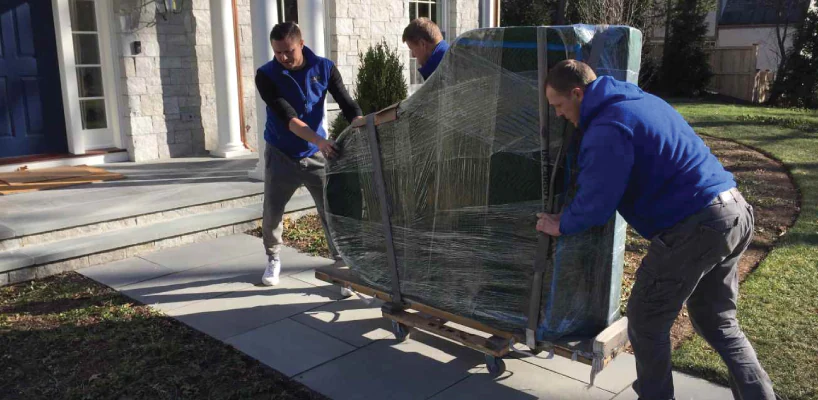Quick answer: A standard refrigerator typically weighs between 200 and 400 pounds in USA. Compact models may weigh around 100 to 150 pounds, while larger USA French door or commercial refrigerators can exceed 500 pounds. The weight depends on size, style, materials, and features like ice makers or smart technology.
Overview
Refrigerators are essential appliances in virtually every modern household, keeping our food fresh, our drinks cold, and our kitchens running smoothly. But one key aspect that often goes unnoticed until it really matters? Their weight.
Whether you're shopping for a new fridge, planning a kitchen renovation, or preparing for a move, knowing how much a refrigerator weighs can save you a lot of hassle.
On average, most full-size refrigerators weigh between 200 and 300 pounds — roughly equivalent to the weight oftwo or three adult humans. Some large refrigerator models, such as French-door or commercial refrigerators, can weigh over 400 pounds.

According to Prudent Reviews, the average refrigerator weighs approximately 250 pounds; however, this varies significantly by type. Mini fridges can weigh as little as 60 pounds, while high-end models can exceed 350 pounds.
Given their bulk and complexity, moving or installing a refrigerator isn’t just a casual task — it requires planning, proper equipment, and sometimes even professional help.
That’s why in this guide; we break down everything you need to know about refrigerator weight and tips for safe moving.
So next time you grab a snack or reach for a cold drink, take a moment to appreciate the engineering and weight behind one of your home's most essential appliances.
Basics of Refrigerator Weight
When we ask, “How much does a standard refrigerator weigh in USA?” it may seem like a simple question, but the answer depends on several key factors.
In simple terms, refrigerator weight refers to the total weight of the appliance, including all its built-in components: the compressor, cooling system, shelving, insulation, and external casing.
This weight is typically measured in pounds (lbs), and it can vary widely based on the size, design, and capacity of the fridge.
Weight by Capacity
One of the biggest contributors to refrigerator weight is capacity, usually measured in cubic feet. A larger capacity means a heavier fridge, but not always. The shape and design of the appliance can make a big difference.
Let’s look at a comparison example:
| Refrigerator Model | Capacity (cu. ft.) | Height (in) | Width (in) | Depth (in) | Weight (lbs) |
|---|---|---|---|---|---|
| Refrigerator A | 20 cu. ft. | 36" | 30" | 28" | 250 lbs |
| Refrigerator B | 15 cu. ft. | 68" | 28" | 25" | 200 lbs |
While Refrigerator A has a larger internal capacity (20 cu. ft.), Refrigerator B is actually taller and deeper — yet it weighs less. This shows how materials, construction, and layout also play a role in overall weight.

The average weight per cubic foot of a standard fridge is around 10 to 15 pounds, based on appliance technician estimates from Don Fuller Appliance Repair.
What does this mean?
When shopping for or moving a refrigerator, don't assume that a bigger capacity equals a heavier appliance. Always check the manufacturer's specifications or user manual, which will usually list the net weight and shipping weight.
For example, the Frigidaire 20 cu. ft. Top-Freezer Refrigerator weighs approximately 155.8 lbs, while a larger 29 cu. ft. French-door model weighs over 350 lbs.
Can I move a fridge by myself?
Yes, you can move a fridge by yourself if it's a smaller model and you have the right equipment, such as an appliance dolly and floor sliders. However, due to the weight and bulk, it’s often safer and easier with help or by hiring professionals.
How Much Do Different Types of Refrigerators Weigh?
When it comes to refrigerator types, two of the most common questions Americans ask are:
“How much does a side-by-side refrigerator weigh?” and
“How much does a mini fridge weigh?”
While those are popular, it’s important to know that refrigerators come in several styles, each with its own size and weight range. Over time, modern refrigerators have become larger and packed with more features, which results in a noticeable increase in average weight.
All weight estimates below are listed in pounds, the standard unit of weight used in the United States.
Average Refrigerator Weight by Type (USA Estimates)
| Refrigerator Type | Average Weight (lbs) |
|---|---|
| Top Freezer | 150 – 250 lbs |
| Freezer | 200 – 350 lbs |
| French Door | 250 – 400 lbs |
| Side-by-Side | 250 – 450 lbs |
| Mini Fridge | 25 – 100 lbs |
Factors Causing the Refrigerator to Be Heavy
Now that we have established an understanding of the average weight, the next step is to examine some of the factors that directly influence the overall weight of the refrigerator.
Material Matters:
- Stainless Steel vs. Other Materials: Stainless steel can add around 15-30% more weight than other materials, but it's durable and stylish.
- Composite Materials: New composite materials aim to reduce weight by up to 20% while maintaining quality.
Cooling Technology:
- Traditional compressor-based systems can contribute to 40-60 pounds of the refrigerator's weight.
- Alternative methods, such as thermoelectric or absorption, can reduce weight by 10-20%.
Size and Configuration:
Larger refrigerators, with capacities exceeding 20 cubic feet, can weigh between 250 and 400 pounds. Additional features, such as ice makers and water dispensers, can add 20-50 pounds.
Energy Efficiency:
Improved insulation can add 5-15 pounds to the refrigerator's weight. LED lighting typically adds less than a pound but significantly reduces energy consumption.
Smart Features:
Touch screens and connectivity features can add 10-30 pounds due to the additional electronics required.
Environmental Impact:
Lighter materials and efficient designs can reduce greenhouse gas emissions by up to 30% during manufacturing and transportation.
Historical Evolution:
Innovations like automatic defrosting have reduced weight by eliminating the need for manual defrosting, saving around 20-40 pounds.
How Do You Move A Heavy Refrigerator By Yourself?
Moving a refrigerator by yourself is possible, but it requires careful preparation, the right tools, and safety precautions to avoid damage or injury.
Refrigerators can weigh anywhere from 150 to over 400 pounds, so moving one isn’t just about muscle — it’s about strategy.

Important: If your fridge weighs over 300 lbs, or if there are stairs, narrow doorways, or tight corners involved, it’s best to get professional help.
Here are some steps to move a refrigerator safely:
Empty the Fridge: Remove all food, trays, and shelves to reduce weight and prevent breakage.
Unplug & Defrost (24 Hours Before): Unplug the unit and allow it to defrost if it has a freezer compartment. Tape the doors shut using painter's tape or bungee cords.
Use a Refrigerator Dolly: A heavy-duty appliance dolly with straps and wheels is essential for moving a refrigerator. Secure the fridge upright to the dolly — never lay it flat during a move.
Slide with Floor Protection: Use furniture sliders or cardboard to gently ease the fridge away from the wall without scratching the floor.
Navigate Slowly: Tilt and roll the fridge carefully, keeping it upright at all times to avoid oil leaking into the cooling system (as warned by GE Appliances).
Secure in Vehicle: If transporting, secure the fridge in an upright position and pad it with blankets or foam.

According to ParcelPath even compact fridges can exceed 100 lbs, which can cause serious strain without proper technique. If you’re unsure or don’t have help, a local moving company is a safer choice.
How Much Should It Cost To Move A Refrigerator?
The cost of moving a refrigerator can vary based on several factors, including distance, size, weight, accessibility (e.g., stairs), and whether it's part of a full home move or a standalone job.
On average, it costs between $100 and $300 to move a standard residential refrigerator within the same city in USA.
For long-distance moves, the cost can increase to $400 or more, depending on total weight and services required.
Average Cost Breakdown
| Move Type | Estimated Cost |
|---|---|
| In-home move (room to room) | $50 – $100 |
| Local move (same city) | $100 – $300 |
| Long-distance move | $300 – $600+ |
| Extra services (stairs, tight spaces, insurance) | +$50 – $200 |
According to Thumbtack, local movers charge around $80–$100 per hour, with a minimum of 2 hours. Moving just a refrigerator can often fall into that range.
Cost-Saving Tips
- Ask appliance retailers: Some stores (like Lowe's or Home Depot) offer free delivery and removal when you buy a new refrigerator.
-
Bundle with other items: If you’re moving other appliances or furniture, it may reduce per-item cost.
-
DIY option: Renting a dolly and truck from U-Haul may cost $40–$70 total but only attempt this if you're confident handling the weight.
While it may be tempting to save money with a DIY approach, the risk of damaging the fridge (or yourself) often outweighs the savings. For most people, spending $100–$300 for professional help offers peace of mind and protection.

Want to know the exact cost to move your refrigerator—or your entire home? Use our Moving Cost Calculator to get an accurate estimate based on your move details.
Special Considerations When Dealing with Refrigerator Weight
Have you ever wondered why some refrigerators seem to tilt or rock? Uneven weight distribution could be the culprit, among many other factors.
This is why we have created a list of some special considerations you must remember.
| Aspect | Consideration |
|---|---|
| Weight Distribution | Evenly distribute weight to prevent strain. For instance, ensure heavy items like motors and compressors are balanced. |
| Placement | Place on a level surface to prevent rocking. Uneven surfaces can cause damage, and even a slight tilt can affect performance. |
| Flooring | Ensure flooring can support weight, especially for built-in or upper-floor installations. For example, a refrigerator can weigh between 200 and 400 lbs. |
| Clearance | Provide ample space for airflow. The manufacturer recommends 1-2 inches (2.5-5 cm) on the sides and rear. |
| Door Swing | Allow sufficient space for the door to open fully. For example, a refrigerator door can extend about 90 degrees when fully opened. |
| Installation Location | Avoid moisture, extreme temperatures, and damage from other appliances. For example, avoid heat sources like ovens to prevent performance issues. |
| Anchoring | Consider anchoring in earthquake-prone areas or with small children. Example: Earthquake straps can prevent tipping during seismic events. |
| Transport Handling | Use proper lifting techniques to avoid injury. Example: Always lift with your legs, not your back, to prevent strains or muscle injuries. |
How to Choose the Standard Refrigerator Size in USA?
As the saying goes, one size doesn’t fit all, and that couldn't be more true when it comes to refrigerators. Choosing the standard fridge size depends on several key factors, including your kitchen space, household size, lifestyle habits, and even your grocery shopping routine.
Measure Your Available Space
Before anything else, measure the refrigerator dimensions of your available space — including height, refrigerator width, depth, and clearance for the doors to open. Don’t forget to allow extra room for ventilation and door swing (usually 1–2 inches on all sides).
Tip: Check the depth of your counters if you're considering a counter-depth refrigerator, which typically ranges from 24 to 30 inches deep.
Match Size to Household Needs
Use this general guideline:
| Household Size | Recommended Capacity |
|---|---|
| 1–2 people | 10–16 cu. ft. |
| 3–4 people | 18–22 cu. ft. |
| 5+ people | 22–30+ cu. ft. |
According to Whirlpool, the average family of four needs at least 19–22 cubic feet of space.
Consider Lifestyle & Food Habits
Think about your shopping and cooking habits:
- Buy in bulk or meal prep often? Go larger.
- Use fresh produce daily? Prioritize refrigerator space over freezer space.
- Frozen foods and batch cooking? Opt for a roomier freezer section.
Factor in Energy Efficiency
Look for refrigerators with the ENERGY STAR® label, which can save you hundreds of dollars over the life of the appliance. These models are certified by the U.S. EPA and are 15–20% more energy efficient than standard models.
According to EnergyStar.gov, certified models use less energy than a 60-watt light bulb running continuously.
Balance Function with Budget
The right fridge isn't just about size — it’s about value. Larger units typically cost more and may use more energy, but choosing the correct size for your actual needs helps you avoid overspending in the long run.
















































































































































 (239) 799–6077
(239) 799–6077